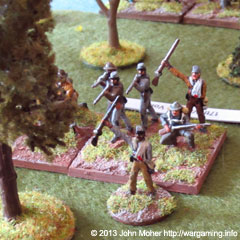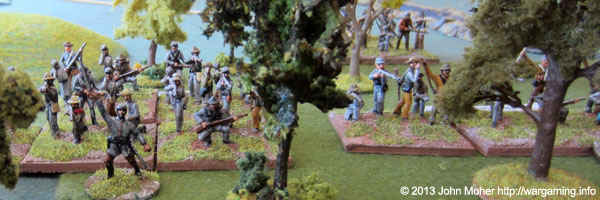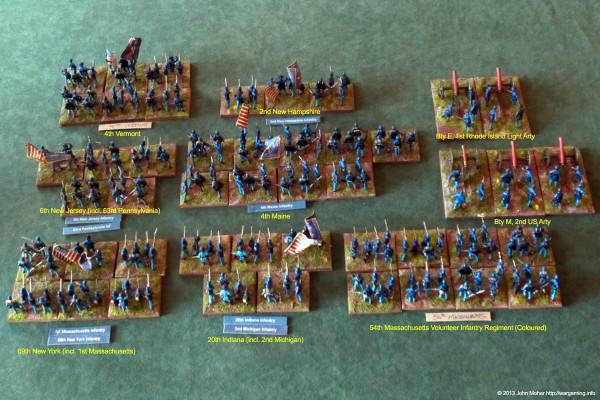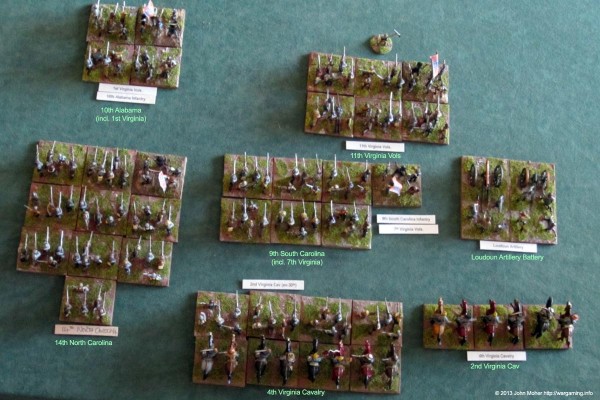Following our army’s defeat at Chancellorsville and our withdrawal back across the Rappahannock we again had a period of some inactivity, during which we reorganised our forces and received further replacements. My Division were in fairly good spirits (as we had been victorious at the Cornfields), but we had a large number of men who had succumbed to injury, wounds, or illness during the previous campaign, and despite the Summer weather attrition had taken it’s toll. However we had also heard the enemy had suffered a great leadership loss, the great Stonewall Jackson had apparently been shot by his own men (a sad end to a great warrior). It was at this juncture, and in anticipation of a new summer campaign in the coming weeks, that I took the difficult decision of merging some of my regiments, their numbers having fallen to only that of the strength of 1-2 companies, and therefore their combat effectiveness was becoming questionable. To try and reduce the resentment this would cause the regiments that were broken up were sent as replacements to their closest ‘neighbouring’ regiments – in the hope this would smooth the transition.

It was therefore with great regret and much remorse that the 1st Massachusetts Infantry were disbanded, and the men sent to the 69th New York State Volunteer Regiment- one of the next most senior regiments in my division, dubbed the “Fighting Sixty-Ninth” (by our enemies we had discovered) and being from New York (which is not too distant from the 1st Massachusetts home town of Boston) it seemed an appropriate home for my Massachusetts veterans. Meanwhile the 63rd Pennsylvania’s men were sent to the 6th New Jersey, and my other most senior regiment, the redoubtable 2nd Michigan was also regrettably broken up to be sent to reinforce the 20th Indiana – which was the least popular of these disbandments and was evidenced by ongoing difficulties with the 20th Indiana’s morale.
However we were boosted by the arrival of 2 new regiments, the veteran 4th Vermont transferred from another division, and the fresh but eager 54th Massachusetts, a fine looking new coloured regiment under Colonel Robert Gould Shaw – although their presence was not always welcomed as warmly as I by all of our troops I am sad to say. My personal morale was also boosted with further promotion, I was now Major General Ulysses P. Rickards, and had also been recognised as a qualified Engineer Officer in addition to my pre-war experience commanding Artillery.

With Battery M, 2nd U.S. Artillery Regiment also brought back up to strength with the arrival of it’s 3rd section my division now subsequently consisted as follows:
- 69th New York “Fighting Sixty-Ninth” (incl. 1st “Mighty” MA – Strength 6; Veteran)
- 6th New Jersey (incl. 63rd Pennsylvania – Strength 5; Veteran)
- 20th Indiana (incl. 2nd Michigan – Strength 5; Veteran)
- 2nd New Hampshire Infantry Regiment (Strength 3; Veteran)
- 4th Vermont Infantry Regiment (Strength 6; Veteran)
- 4th Maine Infantry Regiment (Strength 9)
- 54th Massachusetts (Coloured) Infantry Regiment (Strength 8)
- Battery M, 2nd US Artillery (3 x Rifles)
- Battery E, 1st Rhode Island Artillery (2 x Napoleons)
- Victory Points Accumulated: 14

Meanwhile news reached us that Brigadier General A.P.S. Longman had become an outright celebrity – he had been in all the southern papers and was becoming quite the hero (+4 VPs) – with Stonewall Jackson’s loss the south were obviously keen to find more heroes. Longman’s force had also undergone some reorganisation, and like us had broken up some regiments (1st & 7th Virginians) to reinforce others that had not received any replacements from their depots (1oth Alabama) or were newly arrived but understrength (9th South Carolina). However unlike us his other regiments were receiving a steady trickle of regular replacements, although the 17th Virginia Volunteers & 19th Mississippi had both been entirely destroyed in our cornfield battle, and a small artillery reinforcement also arrived (the balance of the Loudon Artillery Battery):
- 11th Virginia Volunteer Infantry Regiment (Strength 6; Veteran; Sharpshooters)
- 10th Alabama (incl. 1st Virginia Vols – Strength 4; Veteran)
- 9th South Carolina (incl. 7th Virginia Vols – Strength 7)
- 14th North Carolina Volunteer Infantry Regiment (Strength 10)
- 2nd Virginia “Lynchburg Cougars” Cavalry (Strength 3)
- 4th Virginia Cavalry Regiment (Strength 8; Veteran)
- “Loudon” Artillery Battery (1 x Rifle; 1 x 6pdr)
- Victory Points Accumulated: 23

Soon we were headed north, into Pennsylvania, in pursuit of General Lee…
I notice that the forces are quite small in unit numbers in the games, is this due to how the campaign works or more the numbers of troops you have in your collections limiting it a bit?
How do you think the system would handle battles with say 20 units a side or would the size of the card decks become a limiting factor?
cheers
Hi Scruff – Its the campaign process (note we’ve been fiddling around with this a bit though so numbers have been fluctuating), but in general forces slowly get larger as time goes by…
We’ve also had a couple of fairly bloody games which has affected our unit longevity. Ultimately a typical force may be 4-12 units (+ arty) depending on their size and the year of the war…
It is intended to also handle multi-player battles easily (e.g. 2-3 players a side) so will obviously be doing 20+ units a side in that situation…